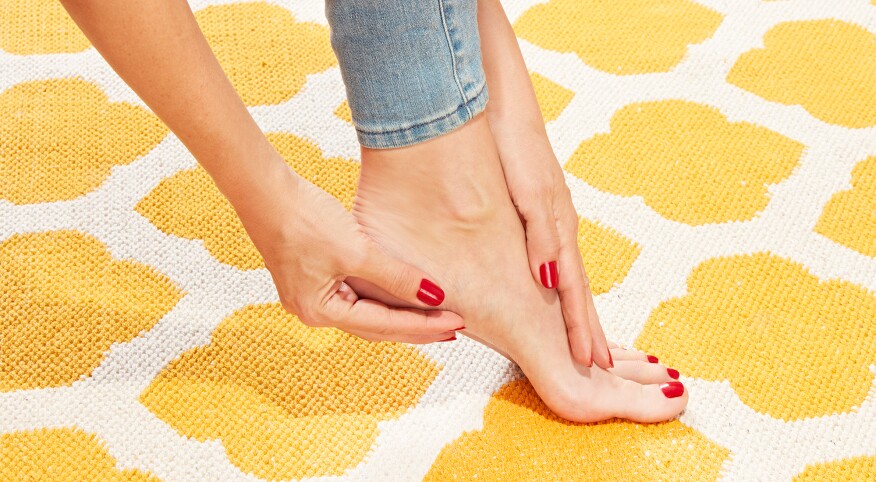Most weekday mornings find me at the gym. I run on the treadmill, jump rope, lift weights or do a combination of all three before I drive home, shower and start work. I thrive on that routine — or I did, until a recent stress fracture derailed my workouts. (Boo!) This is my second stress fracture since turning 50. The cause, per my doc, is likely the combination of getting older and too much of the high-impact activity I love.
But a stress fracture can strike any woman — even after a night in a pair of sky-high stilettos or a long day of hiking in the great outdoors can leave you hurt and hobbling.
While our shoe choices may play a role, age is an inescapable factor when it comes to sore or tender tootsies. Women over 50 are more prone to stress fractures and other foot issues including Achilles tendonitis, plantar fasciitis and bunions, says Chicago-based orthopedic surgeon Neel Pancholi, M.D., of Northwestern Medicine Regional Medical Group.
Here’s a closer look at what your aching feet may be trying to tell you and a sampling of ways you could try to treat common issues.
Foot issue: Achilles tendinitis
What it is: Inflammation in the tendon that attaches the muscles of your calf to your heel.
Cause: Typically overuse (especially too much running) or having tight Achilles tendons.
Symptoms: Pain in your heel and/or back of your foot that worsens with activity; tight feeling in your calf, especially above the heel.
Treatment: Rest (avoid high-impact activities) to let it heal; ice and gentle stretching to help relieve pain.
Prevention: Ramp up physical activity gradually; do regular stretching; ditch your high heels for lower, more comfortable footwear.
Foot issue: Bunion.
What it is: Painful bony bump on the outside of the joint of your big toe.
Cause: Blame your mom — or your dad; 70 percent of people with bunions have a family history of them. Wearing too-tight shoes and simply getting older (an estimated 1 in 3 people over 65 have a bunion) may also put you at higher risk.
Symptoms: Pain in the side of your foot; a big toe joint that bulges out to the side of your foot.
Treatment: Switching to wider shoes and/or orthotics can relieve pressure and pain. If that doesn’t help, your doctor may recommend surgery.
Prevention: There’s not a lot you can do to prevent a bunion, but wearing wider, more comfortable shoes can help prevent bunion-related pain.
Foot issue: Morton’s neuroma.
What it is: A nerve injury that usually strikes between the third and fourth toes.
Cause: Doctors aren’t sure of the cause but wearing tight shoes and high heels and having flat feet or high arches puts you at higher risk for Morton’s neuroma.
Symptoms: Sharp or burning pain in the ball of your foot; tingling between your third and fourth toes; pain that increases when you wear tight shoes.
Treatment: Using a metatarsal pad can take pressure off the nerve, as can wearing wider shoes; if it’s still a problem, a cortisone shot can relieve the pain and irritation. Rarely, surgery is necessary to remove the nerve.
Prevention: You guessed it — swap those stilettos for comfortable, wider shoes with lower heels. Losing weight and changing activities to put less pressure on your foot may help too.
Foot issue: Plantar fasciitis.
What it is: Inflammation of the soft tissue that runs along the bottom of your foot.
Cause: Sudden increase in activity; having flat feet or high arches; tight Achilles tendons; wearing shoes with poor arch support; sudden weight gain. But the American Academy of Orthopedic Surgeons says it develops most often without a specific, identifiable cause.
Symptoms: Pain in the bottom of your foot near the heel that is worse in the morning and after sitting; it may be aggravated by long periods of standing.
Treatment: Rest (stay off your foot as much as possible) and wear a walking boot for 3 to 6 weeks, if possible; ice your foot to reduce pain and inflammation and encourage healing; wear a night splint and/or orthotic in your shoe to help keep the fascia stretched.
Prevention: Ramp up increase in activity gradually and wear shoes that support your arches. Replace your sneakers every six to nine months, and avoid walking barefoot on hard surfaces.
Foot issue: Stress fracture.
What it is: A tiny crack in the one of the bones of your foot.
Cause: Overuse (often too much walking or running) and/or weakened bones postmenopause.
Symptoms: Pain in your foot that worsens with activity; swelling; tenderness.
Treatment: Stay off your foot as much as possible and wear a walking boot, if prescribed, to take pressure off of the bone while it heals. Ice your foot several times a day to reduce swelling and pain. After six to eight weeks, you can gradually start to return to your usual activity level, Pancholi says.
Prevention: Wear supportive, comfortable shoes, and ramp up high-impact activity gradually. And eat a healthy diet rich in vitamin D and calcium.
Taking Care of Your Tootsies
The bad news? Foot pain is common, especially in your mid-40s and beyond. The good is that most foot problems are minor and can often be successfully treated with rest and opting for (sob) more sensible, comfortable shoes.
“If you’re having foot pain, evaluate what kind of shoes you’re wearing and if they’re contributing to your pain,” Pancholi says. If footwear isn’t the culprit, consider whether you’ve recently upped your activity level and switch to non-impact exercise options like biking or swimming to see if that helps. Rest, ice and gentle stretching can help alleviate many symptoms, but if you still have foot pain after a week or two, have it checked out by your doctor.
Have you suffered any of the above foot issues? What did you do? Let us know in the comments below.

Shana Novak (Prop Stylist: Wendy Schelah)
Follow Article Topics: Health








